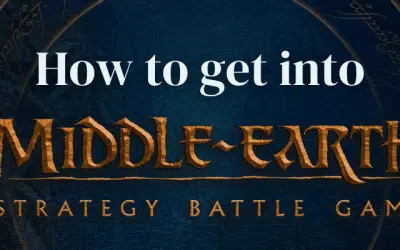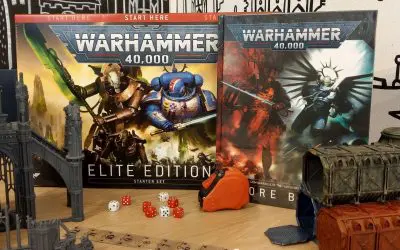Miniature Wargames
Intro to Miniature Wargames

by Raul, Quartermaster @ The Guild Hall
August 16 2019
Many game producers have understood early on that people love the idea of having miniatures in their games. Sometimes, highly detailed miniatures represent soldiers you deploy in a mighty battle. Sometimes these miniatures are just overproduced tokens that represent something trivial such as a region bonus. No wonder that the situation is a bit confusing right now as every game that comes out after a successful Kickstarter campaign looks like a grandiose wargame. However, at the end of the day, everyone loves the tactile sensation of moving a miniature around as opposed to a simple cardboard disc. Oh, and painting miniatures is an entire lifestyle in itself.
So how do we know what games to look for when we want something exciting but also, we desire to get our hands on those fantastic miniatures? Here is a small guide that will possibly shed some light on this subject.
Miniature Wargames
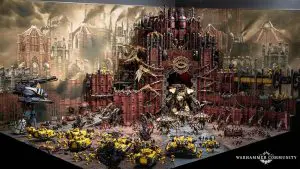
How to recognize them:
- An open table with some battle mat on it (ranging from the simple green tablecloth to vinyl or cardboard maps printed to resemble a landscape)
- Lots of 3D terrain like ruins or buildings, forests, and hills
- Many individual miniatures clumped together in units
- Measuring tools of some kind
- Depending on size, it can take around 3-4 hours to play a game. Or more.
This breed of games is highly dependent, most of the time, on a visual representation of individual soldiers or battalions. Since this is the Miniature Games article, we shall leave out, for now, the excellent wargames that rely on chits and counters to represent armies. Those are a different breed of games for the people who love realism and in-depth simulations of battlefield conditions and units. Miniatures wargames will usually demand a certain number of plastic or metal models to be assembled and put on the table. Along with those you’ll play with a large variety of 3D terrain to represent ruins or alien landscapes.
Freedom of movement and action
The hallmark of these games is the freedom of movement and action. You don’t play on squares or hexagons, you are now dealing with open spaces and movement, and combat is measured in inches or centimeters in any direction. You pick up your miniature and move it a certain number of inches then you measure from it how far it can shoot or attack in close combat. Because of this procedure, things might become a bit inexact.
Of course, freedom comes at a price. You might accidentally move your army too much, or have an entire debate with your opponent if you have line of sight to an enemy miniature or not (this will be solved by crouching down to the level of the miniature and trying to see what it sees through the ruins and barricades), and in the process you might knock down something and find it impossible to put it back on the exact same spot where it was.
Focus on the spectacular visuals
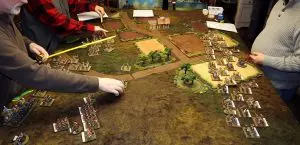
Usually, these games are set in a science fiction or fantasy setting, and as such, the miniatures are very spectacular. They are holding massive weapons or claws, with everything is based around the “cool factor” where realism flies out the window in favor of awesomeness.
Altough games might vary as to size from very small to very large, the core ideas remain the same. They usually have massive rulebooks that deal with the backstory of the setting, lots of rules and rules exceptions, army lists, hobby advice, and more. Most of them will also have individual books for factions present in the game. These faction books are pretty big themselves and have additional rules, and stories for the chosen army. Sometimes you will have additional books with campaigns and new settings that add variation to your games.
Examples: Warhammer 40.000, Warhammer Age of Sigmar, Infinity, Kings of War, Flames of War, Lord of the Rings Strategy Battle Game, Star Wars Armada.
Join the community: At The Guild Hall we have a lot of active communities such as Warhammer 40.000, Warhammer Age of Sigmar, Lord of the Rings: Strategy Battle Game.
Board Miniature Wargames
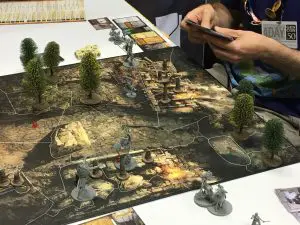
How to recognize them:
- Players have a map in front of them. It usually has regions marked on it (Irregular shapes, squares, hexagons).
- No 3D terrain (typically) as obstacles, ruins or buildings are marked on the map in 2D (you will see the outline of said terrain marked in a different color).
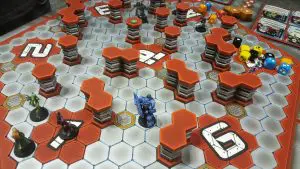
These kind of games are a rather cool combination between the wargames mentioned above and the classic idea of a board game. From the wargames, they will adopt the visual representation of units by using plastic or metal miniatures. From the board game side, they will take the marked board, the more restrictive rules for movement and line of sight, and sometimes some unusual mechanics like activating units by using a deck of cards, or custom dice or a system where units can enable individual special powers by using dice or cards.
These games offer less freedom, but the rules are usually easier to follow and enforce, they are easier to put on the table because they lack the need for 3D terrain. Rulebooks tend to be a lot less hefty, and there usually is little or no background story regarding the setting or the factions fighting in it. They occupy less space on the table and in storage, and they can offer more exciting mechanics inspired by boardgames. They cost a lot less than a fully-fledged wargame, but usually, the miniatures are of a lower quality than those produced for a wargame. Here the accent falls on offering miniatures that don’t need to be assembled (usually they come in one piece).
Examples: Aristeia, Imperial Assault Skirmish, Pantheon Mythic Battles, Battle Lore, Memoir 44.
Not Wargames but lots of Miniatures

Kickstarter is filled with projects that offer all sorts of games filled to the brim with high-quality large size miniatures. It is easy to see why, at first glance, it’s easy to mistake most of them for wargames. Miniatures have become a mandatory part for most games because, at a very superficial level, they bring “value” to the game. You pay a lot for it, but at least you get lots and lots of plastic soldiers or monsters. It is at the end of the day away to overproduce and charge more for games that generally don’t need miniatures to play. But that is your personal preference, and you should buy games based on whatever makes you happy.
Examples: Blood Rage, Rising Sun, Fallout.
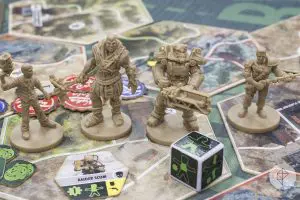
Here are some common characteristics of wargames you will come across most of the time:
- Miniatures that need to be put together using glue and painted if you want that extra eye candy
- Terrain that needs to be put together and painted
- You will often need to buy many boxes to have a functional army. Can get expensive, very fast. Many miniatures you buy will not be used in all games. They are options for that possible moment when you will need them.
- You will need boxes and foam to store and transport your miniatures to the game store where you usually play. This takes lots of space.
- You will need dice. Lots of dice. Usually 6-sided dice. Hope you like rolling dice.
- Miniature Wargames has lots of rules. You will need to have the rule book and faction reference book on hand every game. There will be lots of consulting books and internet forums. As I said, freedom comes at a cost.
If you’d like read more about wargames we have a guide to skirmish miniature warmages, and if you’re living in Cluj you can join the Warhammer community.
Read more from the blog
How to Get Into Middle-Earth Strategy Battle Game (MESBG)
reetings again, fellow wanderer! Do you feel like this scorching weather’s a good time to stay inside and play some wargames? Well, let me tell you all about how you can start your journey in Middle-Earth. Oh, it’s much simpler than at first glance, so you don’t need to sell your soul to Sauron. Well, at least not for this game…
Why Play Middle-Earth Strategy Battle Game (MESBG)
MESBG (Middle-Earth Strategy Battle Game) is a miniatures wargame designed by Games Workshop which puts you in the middle of the greatest moments in The Lord of the Rings and The Hobbit, right alongside all the iconic heroes and villains.
5 Easy Steps to Get Into Wargaming
Thinking of starting to play wargaming but you don’t know where should you start? Here’s 5 easy steps to get into wargaming!

